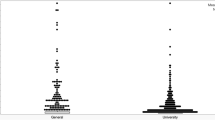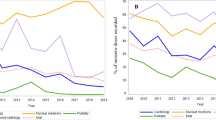Abstract
The impact of occupational radiation exposures on oncology staff working in the disciplines of Nuclear Medicine (NM), Radiotherapy (RT), and Diagnostic Radiology (DR) is of significance to ensure a health risk free environment. In this study, occupationally received radiation doses amongst Pakistani oncology staff in NM, RT and DR during the period (2003–2012) were assessed. The Film Badge Dosimetry (FBD) technique has been utilized to process over 81,000 films (13,237 workers) concerning the occupationally exposed workers data (2003–2012) at a national scale. The annual effective doses were found to range between 0.30–0.97 mSv for NM, 0.44–1.02 mSv for RT and 0.31–1.09 mSv for DR. The annual effective doses averaged over a period of 10 years were assessed to be 0.63, 0.70 and 0.68 mSv for NM, RT and DR respectively. The exposure data were categorized into three exposure levels (≤0.99, 1–4.99 and 5–9.99 mSv) to establish the staff distribution in these categories. It was found that 89.8–96 % in NM, 82–94.5 % in RT and 76–96.8 % staff workers in DR have received doses within the range from the Minimum Detectable Limit (MDL)- 0.99 mSv. The annual effective doses, in all categories, were measured to be less than the recommended annual limit of 20 mSv.





Similar content being viewed by others

References
Prasad KN, Cole WC, Hasse GM (2004) Health risks of low dose ionizing radiation in humans: a review. Exp Biol Med 229(5):378–382
Vañó E, González L, Guibelalde E et al (1998) Radiation exposure to medical staff in interventional and cardiac radiology. Br J Radiol 71(849):954–960
Yoshinaga S, Mabuchi K, Sigurdson AJ et al (2004) Cancer risks among radiologists and radiologic technologists: review of epidemiologic studies. Radiology 233(2):313–321
Cardis E, Vrijheid M, Blettner M et al (2005) Risk of cancer after low doses of ionising radiation: retrospective cohort study in 15 countries. BMJ 331:77–89
Ciraj-Bjelac O, Rehani MM, Sim KH et al (2010) Risk for radiation-induced cataract for staff in interventional cardiology: is there reason for concern? Catheter Cardiovasc Interv 76(6):826–834 15
Miller DL, Vañó E, Bartal G et al (2010) Occupational radiation protection in interventional radiology: a joint guideline of the cardiovascular and interventional radiology society of Europe and the society of interventional radiology. Cardiovasc Interv Radiol 33(2):230–239
Fazel R, Krumholz HM, Wang Y et al (2009) Exposure to low-dose ionizing radiation from medical imaging procedures. N Engl J Med 361:849–857
Weizhang W, Wenyil Z, Ronglin C et al (2005) Occupational exposures of Chinese medical radiation workers in 1986–2000. Radiat Prot Dosim 117(4):440–443
Freedman DM, Sigurdson A, Rao RS et al (2003) Risk of melanoma among radiologic technologists in the United States. Int J Cancer 103:556–562
Muirhead CR, O’Hagan JA, Haylock RG (2009) Mortality and cancer incidence following occupational radiation exposure: third analysis of the national registry for radiation workers. Br J Cancer 100(1):206–212
Martins MB, Alves JG, Abrantes JN et al (2007) Occupational exposure in nuclear medicine in Portugal in the 1999–2003 period. Radiat Prot Dosimetry 125(1–4):130–134
Piwowarska-Bilska H, Birkenfeld B, Listewnik M et al (2010) Long-term monitoring of radiation exposure of employees in the department of nuclear medicine (Szczecin, Poland) in the years 1991–2007. Radiat Prot Dosim 140(3):304–307
Piwowarska-Bilska H, Supinska M, Listewnik M et al (2013) Radiation doses of employees of a Nuclear Medicine Department after implementation of more rigorous radiation protection methods. Radiat Prot Dosim 157(1):142–145
Al-Abdulsalam A, Brindhaban A (2014) Occupational radiation exposure among the staff of departments of nuclear medicine and diagnostic radiology in Kuwait. Med Princ Pract 23(2):129–133
Szewczak K, Jednorog S, Krajewski P (2013) Individual dose monitoring of the nuclear medicine departments staff controlled by Central Laboratory for Radiological Protection. Nucl Med Rev Cent East Eur 16(2):62–65
Sont WN, Zielinski JM, Ashmore JP et al (2001) First analysis of cancer incidence and occupational radiation exposure based on the National Dose Registry of Canada. Am J Epidemiol 153(4):309–318
Masood K, Zafar T, Zafar J (2014) A statistical evaluation of common cancer trends and cancer occurrence by age group in the population of Lahore, Pakistan, 1984–2011. J Registry Manag 41(2):85–90
Masood K, Zafar J, Zafar T et al (2013) Assessment of the occupational radiation exposure doses to workers at INMOL Pakistan (2007–2011). Radiat Prot Dosim 155(1):110–114
Masood K, Ahmad M, Zafar J, Haq M, Ashfaq A, Zafar H (2012) Assessment of occupational exposure among Pakistani medical staff during 2007–2011. Australas Phys Eng Sci Med 35(3):297–300
Niklason LT, Marx MV, Chan HP (1993) Interventional radiologists: occupational radiation doses and risks. Radiology 187(3):729–733
Jabeen A, Munir M, Khalil A, Masood M, Akhter P (2010) Occupational exposure from external radiation used in medical practices in Pakistan by film badge dosimetry. Radiat Prot Dosim 140(4):396–401
ICRP (1998) International Commission on Radiological Protection: History, Policies. Procedures, Elsevier Science Ltd
ICRP (1991a) 1990 Recommendations of the International Commission on Radiological Protection. ICRP Publication 60. Annals of the ICRP 21:1–3
ICRP (2007) The 2007 Recommendations of the International Commission on Radiological Protection. ICRP Publication 103; Annals of the ICRP 37:2–4
Mitchell TJ, Ostrouchov J, Frome EL et al (1997) A Method for Estimating Occupational Radiation Dose to Individuals. Using Weekly Dosimetry Data. Radiation Research 147(2):195–207
Cardis E, Esťeve J (1991) Uncertainties in recorded doses in the nuclear industry: identification, quantification and implications for epidemiological studies. Radiat Prot Dosim 36(2/4):315–319
Thomas D, Stram D, Dwyer J (1993) Exposure measurement error: influence on exposure disease relationships and methods of correction. Annu Rev Publ Health 14:69–93
Acknowledgments
This work was carried out under the auspices of Pakistan Atomic Energy Commission (PAEC) in collaboration with INMOL, Punjab Institute of Nuclear Medicine (PINUM), and Pakistan Nuclear regulatory Authority (PNRA), Islamabad. Immense thanks are due to all PAEC and private sector nuclear medical centers in Pakistan for their cooperation and support regarding data collection.
Author information
Authors and Affiliations
Corresponding author
Rights and permissions
About this article
Cite this article
Zafar, T., Masood, K. & Zafar, J. Assessment of personal occupational radiation exposures received by nuclear medicine and oncology staff in Punjab (2003–2012). Australas Phys Eng Sci Med 38, 473–478 (2015). https://doi.org/10.1007/s13246-015-0368-z
Received:
Accepted:
Published:
Issue Date:
DOI: https://doi.org/10.1007/s13246-015-0368-z



